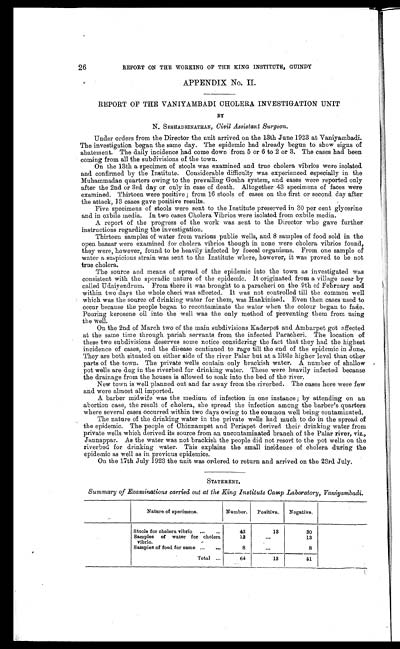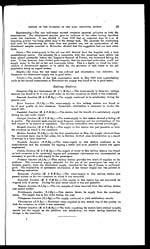Medicine - Institutions > Reports from medical colleges, schools and research institutions > Report of the King Institute of Preventive Medicine, Guindy > Report on the working of the King Institute of Preventive Medicine Guindy for the year 1923-24 (with appendices)
(158) Page 26
Download files
Individual page:
Thumbnail gallery: Grid view | List view

26
REPORT ON THE WORKING OF THE KING INSTITUTE, GUINDY
APPENDIX No. II.
REPORT OF THE VANIYAMBADI CHOLERA INVESTIGATION UNIT
BY
N. SESHADRINATHAN, Civil Assistant Surgeon.
Under orders from the Director the unit arrived on the 13th June 1923 at Vaniyambadi.
The investigation began the same day. The epidemic had already begun to show signs of
abatement. The daily incidence had come down from 5 or 6 to 2 or 3. The cases had been
coming from all the subdivisions of the town.
On the 13th a specimen of stools was examined and true cholera vibrios were isolated
and confirmed by the Institute. Considerable difficulty was experienced especially in the
Muhammadan quarters owing to the prevailing Gosha system, and cases were reported only
after the 2nd or 3rd day or only in case of death. Altogether 43 specimens of faces were
examined. Thirteen were positive; from 16 stools of cases on the first or second day after
the attack, 13 cases gave positive results.
Five specimens of stools were sent to the Institute preserved in 30 per cent glycerine
and in oxbile media. In two cases Cholera Vibrios were isolated from oxbile media.
A report of the progress of the work was sent to the Director who gave further
instructions regarding the investigation.
Thirteen samples of water from various public wells, and 8 samples of food sold in the
open bazaar were examined for cholera vibrios though in none were cholera vibrios found,
they were, however, found to be heavily infected by foetal organisms. From one sample of
water a suspicious strain was sent to the Institute where, however, it was proved to be not
true cholera.
The source and means of spread of the epidemic into the town as investigated was
consistent with the sporadic nature of the epidemic. It originated from a village near by
called Udaiyendrum. From there it was brought to a paracheri on the 9th of February and
within two days the whole cheri was affected. It was not controlled till the common well
which was the source of drinking water for them, was Hankinised. Even then cases used to
occur because the people began to recontaminate the water when the colour began to fade.
Pouring kerosene oil into the well was the only method of preventing them from using
the well.
On the 2nd of March two of the main subdivisions Kaderpet and Ambarpet got affected
at the same time through pariah servants from the infected Paracheri. The location of
these two subdivisions deserves some notice considering the fact that they had the highest
incidence of cases, and the disease continued to rage till the end of the epidemic in June.
They are both situated on either side of the river Palar but at a little higher level than other
parts of the town. The private wells contain only brackish water. A number of shallow
pot wells are dug in the riverbed for drinking water. These were heavily infected because
the drainage from the houses is allowed to soak into the bed of the river.
New town is well planned out and far away from the riverbed. The cases here were few
and were almost all imported.
A barber midwife was the medium of infection in one instance; by attending on an
abortion case, the result of cholera, she spread the infection among the barber's quarters
where several cases occurred within two days owing to the common well being contaminated.
The nature of the drinking water in the private wells had much to do in the spread of
the epidemic. The people of Chinnampet and Periapet derived their drinking water from
private wells which derived its source from an uncontaminated branch of the Palar river, viz.,
Jannappar. As the water was not brackish the people did not resort to the pot wells on the
riverbed for drinking water. This explains the small incidence of cholera during the
epidemic as well as in previous epidemics.
On the 17th July 1923 the unit was ordered to return and arrived on the 23rd July.
STATEMENT.
Summary of Examinations carried out at the King Institute Camp Laboratory, Vaniyambadi.
| Nature of specimens. | Number. | Positive. | Negative. |
| Stools for cholera vibrio | 43 | 13 | 30 |
| Samples of water for cholera vibrio. |
13 | 13 | |
| Samples of food for same | 8 | 8 | |
| Total | 64 | 13 | 51 |
Set display mode to: Large image | Zoom image | Transcription
Images and transcriptions on this page, including medium image downloads, may be used under the Creative Commons Attribution 4.0 International Licence unless otherwise stated. ![]()
| Permanent URL | https://digital.nls.uk/74936793 |
|---|---|
| Description | Appendix No. II. Report of the Vaniyambadi Cholera Investigation Unit |
| Description | 13 titles. Describes research work and conditions, treatments, vaccine production, medical education, public health and disease outbreaks. Extensive tables show mortality rates and patient admissions. These - some from asylums, jails, dispensaries, civil and police hospitals – will be useful to epidemiologists. |
|---|




